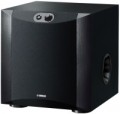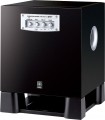Power
Rated power of the subwoofer. Technically, this is the highest average (rms) sound power at which the device can work normally (without sound distortion and damage to components) for an unlimited time. Simply put, the more powerful the subwoofer, the louder it is. The choice for this parameter depends primarily on the size of the space / room that is planned to be covered; detailed recommendations for different situations can be found in special sources.
Also, the power is directly related to the characteristics of the amplifier used with the subwoofer. For active subwoofers (see "Type"), this item actually indicates the nominal power of the built-in amplifier; the speaker itself can be more powerful, but it doesn't matter anymore. For passive models, the power rating corresponds to the highest amplifier power that can be connected to the speaker without the risk of damaging it at high volume.
Crossover frequency
Cutoff frequency of the crossover installed in the subwoofer (or supplied with it — for passive models, see "Type").
The crossover splits the audio signal into separate frequencies so that only the bass goes to the subwoofer and only the main range goes to the speakers. Such a device is mainly equipped with home models (see above). And the crossover frequency is the upper threshold of the frequencies fed to the subwoofer. This information is important for matching with the rest of the speakers: ideally, the lower threshold of the main acoustics should correspond to the upper threshold of the subwoofer, otherwise the frequencies will either overlap or dip in them (neither of which contributes to sound quality). For the convenience of matching, the crossover can be made adjustable (see above).
Passive speaker connection
Ability
to connect a passive speaker system directly to the subwoofer.
Only active models equipped with a built-in amplifier have this possibility (see "Type"). Such an amplifier in this case operates over the entire frequency range and is equipped with a crossover that separates the signal into a “bass” and main range. Bass is fed to the subwoofer's own speaker, and the rest of the frequencies are sent to the outputs for connecting passive acoustics. The role of the latter can be played by high-level terminals or Speakon connectors (see below), depending on the class and purpose of the subwoofer.
Anyway, this function allows you to do without an external amplifier for passive speakers, which is sometimes very convenient.
Inputs
Types and number of inputs provided in the design of the subwoofer. There can be several audio inputs of the same type — this is usually provided for signal switching (for example, to transmit sound to the rest of the acoustics through the built-in subwoofer crossover).
—
RCA (LFE). Dedicated input for connecting a low-frequency audio signal from a preamplifier; in fact, LFE means "low-frequency effects", and RCA is a type of connector (colloquially referred to as "tulip"). It is desirable to connect a signal to such an input from a specialized output “to a subwoofer” or from an external crossover. Note that the LFE input can be provided even in a subwoofer equipped with its own frequency filter: external crossovers often turn out to be of better quality than built-in ones. Most models with this output are domestic (see "Intended use").
—
RCA (linear). Input used to connect the audio signal from the preamplifier. At the same time, unlike the LFE described above, we are talking about all audio frequencies, and not just about bass. The presence of such a connector, usually, indicates the presence of a built-in crossover; also line inputs can be used for audio signal switching, including without processing it (if there are appropriate outputs, see below). Note that in analogue RCA, one connector is needed for each audio channel, so the specific number of connectors may be different; howev
...er, most often there are two of them — for a stereo signal.
— Jack (6.35 mm). Socket for 6.35 mm Jack. This interface is used to connect to both a preamplifier and a power amplifier; it is especially popular in professional studio equipment, although it is also found in other types of audio equipment, including home and concert. The 6.35 mm Jack provides good connection quality, connects and disconnects quickly (although the lack of a lock slightly reduces reliability), and can also be used for balanced audio (see "Balanced XLR" below), although support for this feature in each individual case should be clarified separately. at the same time, there are combo connectors that allow you to connect one of the plugs — Jack (6.35 mm) or XLR.
— Balanced XLR. Distinctive round 3-pin locking connector used for balanced analogue audio preamp connection. The peculiarity of this connection is that, due to the specific method of signal transmission, the cable itself plays the role of an interference suppressor, which allows the use of rather long wires without compromising the purity of the sound. Because of this, as well as the reliability of the connection, XLR has become very popular in high-end audio equipment, including studio and live equipment. One connector of this type is responsible for one channel of sound, therefore, in subwoofers with support for stereo signal switching, the XLR input can consist of 2 connectors; this may be specified in the specifications.
— Balanced digital ( AES/EBU). Professional interface for digital audio transmission. It uses the same connector and cable as the balanced XLR described above, but differs in signal type (besides, all channels are transmitted via one connector with this connection). At the same time, AES/EBU has all the advantages of a balanced connection, including high noise immunity even with long cable lengths. To reproduce such an audio signal on the subwoofer itself, it is necessary that the latter has not only an amplifier, but also its own DAC, which greatly complicates and increases the cost of the design. In addition, AES/EBU outputs are found mainly in high-end professional audio equipment. Thus, subwoofers with such an input are extremely rare, mainly among advanced models for studio and concert purposes. And even in such models, only the switching of a digital signal to a similar output can be provided, and not its reproduction.
— Speakon. Connector used in professional audio equipment to connect to a power amplifier. Its specific features are the ability to work with high currents and increased protection from human contact with live parts. This made the Speakon very popular in live gear; however, there are also home subwoofers (see "Intended use") with such inputs.
— High-level(terminals). Input for connecting a signal from a power amplifier. It is one of the most popular connection interfaces for passive subwoofers (see "Type"), however, it can also be provided in active ones — in case an external bass amplifier is available, better than the built-in one. One input provides a pair of terminals and allows you to transmit one channel of sound — this is enough when connecting a subwoofer to an external crossover. However, there can be two high-level inputs (and four terminals, respectively) — this means that the audio signal can be transmitted to the rest of the audio system components through the built-in crossover.
— Trigger. Service input used to automatically turn on the subwoofer. It is enough to connect the corresponding output of another audio system component (for example, an audio receiver) to the trigger input — and each time this component is turned on, the “sub” will receive a control signal and turn on too, which will save the owner from having to “wake up” the device separately.Material
- MDF. Medium-density fiberboard is one of the most popular materials for modern speaker cabinets, including subwoofers. This is due, on the one hand, to the relatively low cost and neat appearance, and on the other hand, to excellent acoustic characteristics.
MDF cases are found in “subs” for all purposes and price categories.
- Tree. Natural wood is well suited for low-frequency acoustic enclosures; its performance characteristics are comparable to MDF described above. At the same time, this material is considered more “natural” and has its own beautiful surface pattern, but is noticeably more expensive. Therefore, although
wooden cases are common, they are not as widespread as MDF.
- Plastic. The main advantage of plastic is its low cost, but it is very difficult to create a body with the necessary acoustic characteristics from this material. Therefore,
plastic subwoofers are extremely rare, mostly built-in models.
- Metal. In this case, we mean various alloys and aluminium models. The metal is highly durable, but the acoustic characteristics are far from optimal. This requires the use of various tricks, which respectively affect the price
of a metal subwoofer. Therefore, this option is quite rare.

